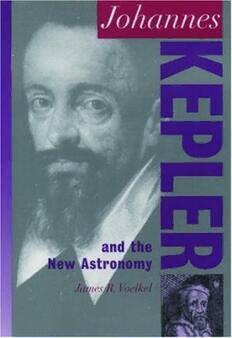Table Of ContentJohannes Kepler
and the New Astronomy
O
XFORD
PORTRAITS
IN SCIENCE
Owen Gingerich
General Editor
Johannes Kepler
and the New Astronomy
James R. Voelkel
Oxford University Press
New York • Oxford
for Katy
Oxford University Press
Oxford New York
Auckland Bangkok Buenos Aires Cape Town Chennai
Dar es Salaam Delhi Hong Kong Istanbul Karachi Kolkata
Kuala Lumpur Madrid Melbourne Mexico City Mumbai Nairobi
Sao Paulo Shanghai Taipei Tokyo Toronto
Copyright © 1999 by James R. Voelkel
Published by Oxford University Press, Inc.
198 Madison Avenue, New York, New York 10016
www. oup. com
Oxford is a registered trademark of Oxford University Press
All rights reserved. No part of this publication
may be reproduced, stored in a retrieval system, or transmitted,
in any form or by any means, electronic, mechanical,
photocopying, recording, or otherwise, without the prior
permission of Oxford University Press.
Design: Design Oasis
Layout: Leonard Levitsky
Picture research: Lisa Kirchner
Library of Congress Cataloging-in-Publication Data
Voelkel, James R. 0ames Robert)
Johannes Kepler and the New Astronomy / James R. Voelkel
p. cm. — (Oxford portraits in science)
Includes bibliographical references and index.
Summary: A biography of the German astronomer who discovered three
laws of planetary motion.
ISBN-13: 978-0-19-511680-9 (hardcover); 978-0-19-515021-6 (paperback)
ISBN-10: 0-19-511680-1 (hardcover); 0-19-515021-X (paperback)
1. Kepler, Johannes, 1571-1630 Juvenile literature. [1. Kepler, Johannes,
1571-1630. 2. Astronomers.] I. Title. II. Series.
QB36.K4V64 1999
520'.92—dc21 99-23844
[B] CIP
987654
Printed in the United States of America
on acid-free paper
On the cover: Portrait of Kepler by Hans von Aachen (1612). Scholars are not entire-
ly certain that this portrait depicts Kepler. Inset: Detail of the frontispiece of the
Rudolfine Tables showing Kepler at work.
Frontispiece: Copperplate engraving of Kepler (1620) by Jacob von Heyden, after a
portrait by an unknown artist.
Contents
Chapter I: The Comet 8
Sidebar: Copernicus's Model of Retrograde Motion . .21
Chapter 2: The Secret of the Universe 25
Sidebar: The Platonic Solids 30
Chapter 3: The New Astronomy 47
Sidebar: Uraniborg Observatory 50
Sidebar: Kepler's First Two Laws 65
Chapter 4: The Harmony of the World 75
Sidebar: Kepler's Third Law 92
Chapter 5: Witch Trial 95
Chapter 6: The Dream 113
Epilogue 131
Chronology 133
Further Reading 137
Index 139
OXFORD
PORTRAITS
INS
CIENCE
Charles Babbage
Alexander Graham Bell
Nicolaus Copernicus
Francis Crick
& James Watson
Marie Curie
Charles Darwin
Thomas Edison
Albert Einstein
Michael Faraday
Enrico Fermi
Benjamin Franklin
Sigmund Freud
Galileo Galilei
William Harvey
Joseph Henry
Edward Jenner
Johannes Kepler
Othniel Charles Marsh
& Edward Drinker Cope
Gregor Mendel
Margaret Mead
Isaac Newton
Louis Pasteur
Linus Pauling
Ivan Pavlov
"It can be said that among the men whose genius enriched and deep-
ened human knowledge by creative achievements in the area of exact
science there is hardly one who enjoys the sympathy of as many as
does Kepler, despite the facts that his principal field of activity is unfa-
miliar to most and that the result of his labors is difficult to understand
and appreciate. It is the halo of his personality which draws many under
his spell, the nobility of his character which makes friends for him, the
vicissitudes of his life which arouse sympathy, and the secret of his union
with nature that attracts all those who seek something in the universe
beyond, and different from, that which rigorous science offers. In their
hearts they all quietly bear veneration and love for this exceptional man.
For no one who has once entered the magic sphere that surrounds him
can ever escape from it."
—Max Caspar, Kepler
This contemporary woodcut depicts the Comet of 1577. The artist has included himself in the foreground, sketching
the comet with the help of an assistant who holds a lantern.
CHAPTER
1
The Comet
The year 1577 was graced with one of the most spectacular
comets in recorded history. With a resplendent head that
outshone any star and a tail 50 times the breadth of the full
moon, it wheeled majestically through the heavens, exciting
attention and comment throughout Europe. Deep in south-
ern Germany in the duchy of Wurttemberg, Katharina
Kepler led her five-year-old son Johannes up the hill over-
looking the village of Leonberg to view the spectacle. His
weak vision made more bleary by the late hour, the comet
did not make much of an impression on him. But he would
always remember his mother's kind gesture from an other-
wise harsh and difficult childhood. At the same moment,
far to the north on his private island in the Danish Sound, a
young nobleman took time out from the task of building
the world's greatest astronomical observatory to make
detailed nightly observations of the comet.
Comets appear without warning in the heavens, which
are otherwise the most regular and enduring feature of our
environment. As such, at the time comets were viewed as
fateful omens, signs that a change was in store. If the magnif-
icence of the sign were any indication of its significance, this
9

